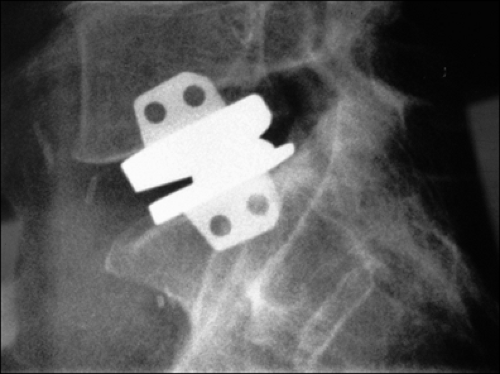Charité III Artificial Disc Replacement: Indications, Preoperative Examinations, and Contraindications
B. Poffyn
G. Sys
D. Uyttendaele
The Charité III intervertebral disc prosthesis is the most widely used artificial disc replacement (ADR) in the world for the treatment of lumbar degenerative disc disease (DDD). Artificial discs (ADs) are primarily designed to relieve pain and to preserve the range of motion, while providing segmental stabilization and restoring the natural function of the disc.
The success depends on proper patient selection for this type of surgery. A systematic standard battery of technical investigations and a course of conservative treatment in the preoperative period are mandatory to achieve a good outcome.
Preoperative Examinations
The preoperative examinations that are necessary for a correct diagnosis include x-rays, dynamic x-rays, magnetic resonance imaging (MRI), facet blocks, and discography.
Plain x-rays demonstrate single- or multiple-level DDD, spondylolisthesis, and spondylolytic problems. Spondylodiscitis, infections, spinal tumors, translational instabilities and retrolisthesis/anterolisthesis are identified on anteroposterior and lateral views. Dynamic x-rays disclose ligamentous hypermobility and anteroposterior slip due to instability.
MRI provides an appreciation of disc degeneration, with or without Modic changes and also detects disc fragment expulsion, disc herniation, discitis, tumors, and fractures.
In cases of radiographic suspicion of osteoporosis and in female patients older than the age of 45 years preoperative dual-energy x-ray absorptiometry (DEXA) is mandatory.
Facet blocks at the involved level can indicate whether the facet joints are the pain generators. If they are, complete pain relief will be obtained after injection of lidocaine. If the pain fails to disappear, it does not originate in the facet joints.
Discography is one of the most important examinations. Through the injection of radio-opaque fluid the pressure in the affected disc is increased. If the disc is pathologic, the pain the patient experiences in daily life can be reproduced. Discography at the level above and below the “black disc” is very important to document that the affected disc actually is the pain source in that particular patient.
Stay updated, free articles. Join our Telegram channel

Full access? Get Clinical Tree









